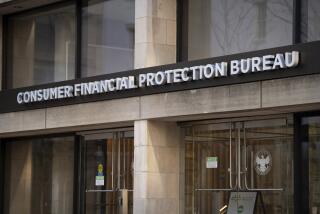Fed Moves to Curb Predatory Lending
- Share via
Vastly more high-cost home loans will fall under strict federal disclosure and lending guidelines, thanks to Wednesday’s Federal Reserve Board ruling aimed at curbing so-called predatory lending.
The action, which amends the truth-in-lending law, was hailed as a step in the right direction, but some consumer advocates maintain that the Fed did not go far enough to suppress abusive practices that have burgeoned with the growth in the sub-prime mortgage market.
“I’m glad to see the Federal Reserve finally starting to live up to some of its responsibilities to help protect consumers from predatory lending abuses,” said Maude Hurd, president of the Assn. of Community Organizations for Reform Now, a consumer group that has launched a national fight against predatory loans. “However, the Fed could have taken much stronger steps against loan ‘flipping’ and other deceptive lending practices.”
By unanimous vote, Federal Reserve governors lowered the interest rate thresholds that bring first mortgage loans under the more stringent disclosure and lending guidelines of the Home Ownership and Equity Protection Act, a 1994 law aimed at protecting consumers who secure high-cost loans. In addition, the cost of credit insurance was added into the mix when determining whether the loan fees were high enough to trigger the borrower protection law.
The law currently affects about 12.4% of the first mortgages and 49.6% of the second mortgages written in the sub-prime mortgage market, which accounts for about $160 billion in mortgage loan originations each year.
Sub-prime lenders cater to borrowers with spotty credit. These loans are usually more expensive than loans made to lower-risk borrowers. The loans are referred to as predatory if the terms are misrepresented by the lender or the loan costs are unusually high.
Under the new rules, which go into effect in October, nearly 38% of the first mortgages and 61% of the second mortgages written by sub-prime lenders will be protected by the law.
The law’s protections are focused on providing clear disclosures of loan costs, terms and fees. The law also prohibits certain practices, including extending credit to borrowers who do not have the ability to repay. (Some consumer advocates maintain that the worst predatory lenders make loans with the intention of foreclosing.)
The Fed’s action Wednesday would strengthen this prohibition by requiring lenders to verify and document the borrower’s income. If the lender does not maintain this documentation, regulators can assume that the loan violates the law.
In addition, the guidelines were altered by the Fed to bar lenders from refinancing their own high-cost loans within a year, unless the lender can establish that the new loan is in the borrower’s best interest. That’s aimed at stopping an abusive practice called flipping, in which borrowers are talked into trading one high-cost loan for another, generating huge commissions and fees for the lender while impoverishing the borrower.
What the Fed didn’t do was ban sub-prime lenders from refinancing no-cost and low-cost loans that some low-income borrowers secure through community groups and charitable organizations. Consumer groups had attempted to get this prohibition written into the law to ensure that unsophisticated borrowers wouldn’t be talked into trading cut-rate financing for a high-cost loan.
“The rules are a measured response that balances various concerns, so as not to impede the growth of the legitimate sub-prime mortgage market,” Fed Gov. Edward M. Gramlich said.
Gramlich said that although these Fed moves should help curb predatory loans, the problem can’t be resolved by regulation alone. Consumers need to become better informed and take more care before signing loan documents.
More to Read
Inside the business of entertainment
The Wide Shot brings you news, analysis and insights on everything from streaming wars to production — and what it all means for the future.
You may occasionally receive promotional content from the Los Angeles Times.










